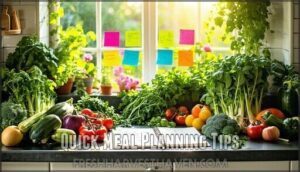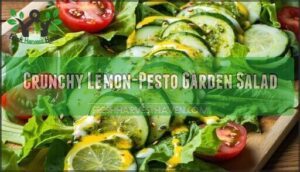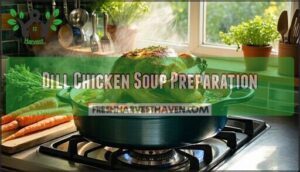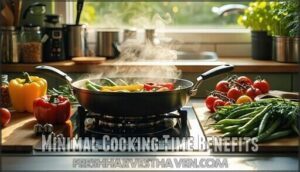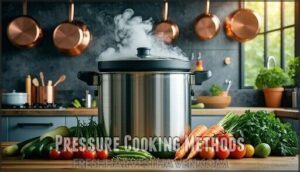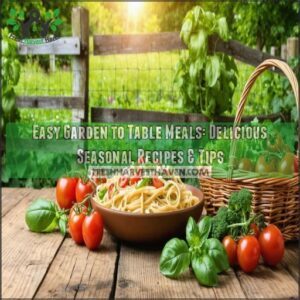This site is supported by our readers. We may earn a commission, at no cost to you, if you purchase through links.
 Garden harvest quick meals transform your backyard bounty into nutritious dishes without the time commitment. Growing your own food reduces pesticide exposure while preserving peak nutrients through minimal cooking methods like steaming and pressure cooking.
Garden harvest quick meals transform your backyard bounty into nutritious dishes without the time commitment. Growing your own food reduces pesticide exposure while preserving peak nutrients through minimal cooking methods like steaming and pressure cooking.
Quick prep techniques—from one-pan preparations to strategic batch cooking—let you enjoy fresh flavors faster, and composting scraps or freezing surplus ensures nothing goes to waste.
Seasonal eating adds variety to your table while supporting your garden’s natural rhythm, making meal planning simpler and more sustainable. Smart cooking techniques preserve the vitamins, minerals, and antioxidants you worked hard to grow, turning garden-to-table cooking into a simple routine that celebrates the season’s best.
Table Of Contents
- Key Takeaways
- Garden Harvest Benefits
- Quick Meal Planning Tips
- Garden Fresh Recipes
- Cooking Techniques Preservation
- Meal Preparation Efficiency
- Frequently Asked Questions (FAQs)
- What can you do with fresh vegetables?
- How do I use up vegetables from my garden?
- What to eat for farmers?
- When should you eat a vegetable garden?
- What is fresh harvest Haven?
- Why do you need a vegetable Harvester?
- How do I store freshly harvested vegetables properly?
- What equipment is essential for quick garden cooking?
- Can I substitute garden vegetables in any recipe?
- How long do homegrown vegetables stay fresh?
- Conclusion
Key Takeaways
- Growing your own vegetables cuts pesticide exposure and preserves nutrients through minimal cooking methods like steaming and quick sautéing, which lock in vitamins better than boiling or extended heat.
- Smart prep strategies—including batch cooking, one-pan meals, and freezing surplus harvest—help you transform fresh produce into weeknight dinners without spending hours in the kitchen.
- Eating seasonally from your garden adds natural variety to your menu while reducing waste through composting scraps, sharing extras, and preserving peak-season bounty.
- Raw and lightly cooked vegetables deliver maximum fiber, enzymes, and antioxidants, making garden-to-table cooking a simple routine that celebrates fresh flavors while supporting your health.
Garden Harvest Benefits
Growing your own food offers more than just tasty veggies on your plate. Here are the best reasons to enjoy what your garden gives.
Pesticide Reduction Methods
When you roll up your sleeves in your own garden, you get to choose what goes on your veggies—and that means saying goodbye to those mystery pesticides you worry about at the store. You can tap into organic pesticides and clever companion planting to keep your crops thriving without harsh chemicals. Letting natural predators (think ladybugs) do some of the work, along with rich soil health, pays off season after season.
If you’re curious where to start, try these practical ideas:
Here are some solid starting points:
- Attracting natural predators like ladybugs
- Composting for improved soil health
- Spraying with gentle, organic options such as neem oil
- Rotating crops to disrupt pest cycles
Nutrient Density Preservation
Gardening lets you tap into every bit of nutrition from your veggies. Freshly picked produce starts losing vitamin retention the moment it leaves the vine—so your quick action turns into a nutrient-preservation win.
Minimal cooking time, especially steaming, locks in vitamins and boosts mineral bioavailability. Raw vegetable nutrition stands tall in salads, while brief sautéing avoids the nutrient loss found in long boils. Certain cooking methods, however, can increase the bioavailability of nutrients, making them more accessible to the body.
Here’s how methods compare:
Let’s break down how each method stacks up:
|—————————|——————|————————|
| Steaming | High | Excellent |
| Quick Sauté | Moderate | Good |
| Microwaving | Variable | Fair |
| Boiling | Low | Poor |
| Raw | Highest | Variable |
Waste Reduction Strategies
You’ve worked hard to grow nutrient-rich veggies—let’s make sure every bit gets used, not wasted. Waste reduction strategies help you stretch your harvest and save cash. Composting methods return nutrients to your soil, while regrowing scraps—like green onions—creates a cycle of abundance. Community gardens often encourage surplus sharing so no tomato goes forgotten. And don’t underestimate food preservation: freezing or batch-cooking are key zerowaste cooking tips, making garden harvests last well beyond their prime. To extend the life of your harvest, consider various storage methods like freezing or root cellaring.
- Try composting kitchen scraps.
- Regrow veggie ends on your windowsill.
- Share extra produce with neighbors.
- Use quick freezing or canning as food preservation staples.
Seasonal Eating Advantages
After finding smart ways to use every last carrot and tomato, it’s a real joy to start planning meals around what’s freshly bursting from your own backyard each season. Choosing seasonal ingredients means Local Food Sourcing at Peak Flavor Seasons—think crisp lettuce in spring or bold tomatoes in summer.
This approach adds Dietary Variety, celebrates fresh produce, reduces food miles, and lessens Environmental Impact. Seasonal eating keeps garden harvest meals lively and deeply flavorful.
Quick Meal Planning Tips
If you want to cook faster with what you’ve just picked, a little planning goes a long way.
Want to cook faster with what you’ve just picked? A little planning goes a long way.
Here’s how you can make more of your harvest without spending all day in the kitchen.
Garden Inventory Management
Ever wish you could open your back door and know exactly what fresh treasures are waiting to be turned into dinner? Good garden management starts with simple harvest tracking—think quick notes or inventory software.
Storage solutions like cool bins and crispers stretch freshness, while succession planting keeps your options open.
Smart planning means less waste, more variety, and a steady stream of vibrant, homegrown ingredients.
Recipe Adaptation Techniques
Whenever your kitchen fills up with the latest garden harvest, recipe adaptation is your ace in the hole. Lean on Seasonal Substitutions—try trading zucchini for pasta to cut carbs, or kale for spinach for a fresh twist. Technique Adaptations like roasting or steaming help coax big flavors out of simple, fresh ingredients. Staying nimble means you get the most from Nutrition Optimization and Storage Flexibility, all without losing Recipe Integrity. Quick meals get tastier and more adventurous when you know how to match flavors and adjust portions on the fly.
- Mix and match seasonal veggies
- Adjust portions to your harvest
- Roast, steam, or grill for new textures
Meal Prep Time Reduction
When you carve out a little time on Sunday to chop and organize, weekday dinners suddenly feel a whole lot easier. Use efficient chopping and bulk ingredient prep to breeze through meal assembly. Jot down quick marinades or simple sauces for flavor, and remix leftovers for 30-minute meals. These timesaving tips turn the week’s garden harvest into dinner magic—no dance routine required.
| Prep-Ahead Steps | Quick Marinades | Leftover Remixes |
|---|---|---|
| Chop all veggies | Lemon-herb blend | Stir-fry bowls |
| Portion greens | Balsamic vinaigrette | Veggie omelets |
| Pre-cook grains | Garlic-orange glaze | Salad wraps |
| Shred cheese | Soy-ginger splash | Garden pasta |
Batch Cooking Methods
Imagine having your week’s garden harvest already working for you before you even step into the kitchen. Batch cooking lets you use your time and veggies wisely—think big pots, smart portioning strategies, and savvy storage solutions. Freezing techniques protect flavor, while recipe scalability means you’re not cooking from scratch every night.
Here’s how to boost meal prep efficiency:
Want to make meal prep easier?
- Pre-chop veggies for quick meal assembly.
- Slow-cook bulk stews for simple dinners.
Garden Fresh Recipes
There’s nothing like using your own garden haul to whip up something fresh for dinner.
Here are some of my favorite recipes that bring those just-picked flavors to the table.
I’ve rounded up some of my go-to recipes that make the most of those just-picked flavors.
Stuffed Poblano Peppers Recipe
Looking for a way to brighten up dinner with bold flavors and garden-fresh flair? Start with roasted poblanos—native to Mexico’s Puebla region—and fill them with your favorite garden harvest. Mix up stuffing variations with black beans, rice, or sweet corn. Pair with melty cheese and keep the spice level mild. For fast, impressive quick meals, try these combos:
| Pepper Roasting Tips | Stuffing Variations | Cheese Pairings |
|---|---|---|
| Broil 6 min/side | Rice, beans, sweet corn | Queso fresco |
| Peel blistered skin | Mushrooms, kale, herbs | Monterey Jack |
| Slice lengthwise | Quinoa, tomatoes | Cheddar |
| Remove seeds gently | Zucchini, black beans | Pepper Jack |
| Lay flat to stuff | Spinach, lentils, onion | Goat cheese |
Crunchy Lemon-Pesto Garden Salad
There’s something about a crisp garden salad layered with lemony pesto that wakes up even a tired weeknight and makes your taste buds sit up and pay attention.
To build a Crunchy Lemon-Pesto Garden Salad:
Here’s how to build a Crunchy Lemon-Pesto Garden Salad:
- Toss garden lettuce, cucumbers, and tomatoes for Salad Texture Variety.
- Stir in generous lemon zest—those Lemon Zest Benefits brighten every bite.
- Pair with toasted seeds for crunch and simple Garden Salad Pairings.
Dill Chicken Soup Preparation
If you’re ready to trade salad tongs for a sturdy soup spoon, let’s simmer up a pot of homemade dill chicken soup that brings out the best in simple garden goodness.
Start your Dill Chicken Soup Preparation by searing whole chicken—this unlocks Broth Flavor Building and Chicken Tenderness Secrets. Add quick meal ingredients like carrots, leeks, and garden-fresh herbs.
Gently stir in fresh dill at the end for greatest Fresh Dill Impact and bright, herbal creaminess.
Cajun Sirloin With Mushroom Leek Sauce
Just as that steaming dill chicken soup warms the soul, nothing finishes a day quite like sinking your fork into a Cajun-spiced sirloin, drenched in a silky mushroom leek sauce.
Pick a first-rate sirloin cut—thick, marbled, and ready for quick meals. Dust with Cajun spice blends, sear over high heat, then let mushrooms and leeks join the party. Practice savvy leek preparation methods for sweet richness and use mushroom variety pairing for earthy depth. Manage sauce consistency control by simmering gently.
- Sear sirloin hot and fast for steakhouse results.
- Slice only light leeks to avoid bitterness.
- Add wine for a lush, harvest-flavored sauce.
Cooking Techniques Preservation
Getting the most from your garden harvest is all about how you treat those fresh-picked ingredients. Here are some simple, smart ways to keep nutrients in and prep time low.
Fresh-picked vegetables deserve better than nutrient-draining prep methods. Try these practical techniques to preserve what you’ve grown while cutting down on kitchen time.
Minimal Cooking Time Benefits
When you spend less time cooking your garden harvest, you hold onto both the bright flavors and the good-for-you nutrients that make those fresh veggies shine. Quick meals—think stir-fried beans or a 30-minute veggie medley—amplify Nutrient Retention and boost your Time Management.
Fast cooking means Energy Savings and Flavor Preservation, letting you enjoy crisp textures. Immediate cooking isn’t just a Convenience Factor—it turns your quick meal ingredients into goodness without delay.
| Benefit | Quick Cooking Impact |
|---|---|
| Nutrient Retention | Higher in quick meals |
| Energy Savings | Lower utility costs |
| Flavor Preservation | Enhanced, fresh taste |
| Time Management | Less time in the kitchen |
| Convenience Factor | Easy, flexible prep |
Steaming Nutrient Preservation
Quick meal prep gets even better with steaming—your veggies hold onto their Vitamin Retention, Antioxidant Stability, and Mineral Retention like champions.
Quick meal prep gets even better with steaming—your veggies hold onto their Vitamin Retention, Antioxidant Stability, and Mineral Retention like champions.
When you’re working with garden-fresh produce, try these tips to lock in maximum nutrients:
- Limit steaming to 3-5 minutes.
- Keep pieces uniform.
- Use minimal water.
- Close the lid.
- Enjoy nutrient-dense meals with steady Protein Retention.
Raw Vegetable Nutrition
Step outside on a crisp morning and pick raw vegetables from your garden—you’re locking in the best nature can offer. With each bite, you tap into peak Fiber Content, Vitamin Retention, and vibrant Antioxidant Levels that garden harvest quick meals are famous for. Here’s why raw is a powerhouse in nutrient preservation:
- Enzyme Activity soothes your digestion.
- Fiber Benefits keep your gut thriving.
- Vitamin Retention is highest, especially for vitamin C and folate.
- Mineral Density, like magnesium, peaks in absorption with little Caloric Value.
Pressure Cooking Methods
Even on the busiest nights, pressure cooking turns your garden veggies into warm, nourishing meals faster than you’d think. The pressure cooker locks in flavor and nutrients that often drift away with long simmering—think vibrant carrots or tender greens in minutes.
With reliable Cooking Time Charts and careful Pressure Cooker Safety checks, you can convert almost any quick garden recipe for perfect results, even at higher altitudes.
This method shines for farm-fresh Nutrient Retention and easy batch-cooking, making wholesome meals truly simple.
Meal Preparation Efficiency
Making the most of your garden harvest means finding ways to prep meals quickly without sacrificing flavor or nutrition.
Getting the most from your garden harvest starts with smart prep strategies that keep meals both quick and nutritious.
A few simple steps can turn those fresh ingredients into weeknight solutions without the usual hassle.
One-Pan Meal Preparation
Who says you need a pile of pots to turn garden veggies and simple proteins into a meal that practically cooks itself? One-pan cooking is your shortcut to quick garden recipes—delivering balanced nutrition with flavor combinations that shine. Sheet pan meals bring efficient cleanup and simplified cooking to your weeknights. Ready for a playbook?
Why clutter your counter with pots when garden veggies and protein can share one pan? One-pan cooking turns fresh ingredients into complete meals with minimal fuss—you get balanced nutrition, bold flavors, and cleanup that takes seconds.
Sheet pan dinners work especially well on busy weeknights. Here’s how to make them happen:
- Start hearty roots first, add greens at the end.
- Cast iron goes from stovetop to oven.
- Keep seasonings honest—herbs, oil, and salt.
Freezing Garden Harvests
Imagine turning your garden’s sunniest days into easy winter meals, all thanks to a freezer stocked with your homegrown veggies. Smart blanching techniques—usually just two to four minutes in boiling water—lock in color and flavor, setting the stage for prime packaging.
Zip-top bags or vacuum-sealed pouches go a long way in warding off freezer burn, making your homemade food preservation efforts last. Storage duration depends on the vegetable, but you’ll usually get eight to twelve months of tasty greens and roots ready for harvest recipes year-round.
When it’s time to thaw, try direct-to-pan stir-fries or let veggies sit in the fridge overnight. Freezing chopped herbs in oil-filled ice cube trays turns summer’s abundance into punchy flavor bombs, guaranteeing your winter convenience meals are anything but bland.
Combining Garden Vegetables
Ever looked at your garden haul and wondered how those colors and flavors might dance together on your plate? Mixing garden vegetables isn’t just about looks—it’s about creating seasonal blends with smart flavor pairings, playful texture combinations, and beautiful color palettes.
Your garden’s bounty tells a story in color and taste—one you get to compose.
Pairing vegetables isn’t just aesthetic; it’s about building seasonal combinations where flavor, texture, and hue work together.
When leafy greens meet crisp peppers and sweet carrots, you’re creating dishes that maximize nutrients and turn fresh produce into satisfying meals.
Herb Garden Flavor Enhancement
Fresh herbs from your backyard aren’t just garnishes—they’re flavor powerhouses that can turn a simple garden harvest meal into something memorable with just a pinch or two. Understanding herb pairings unlocks those aromatic compounds that make your dishes sing. When you snip fresh basil leaves for tomato sauce or add rosemary to roasted vegetables, you’re tapping into culinary uses that chefs have relied on for centuries.
Fresh herbs from your backyard aren’t just garnishes—they’re flavor powerhouses that can turn a simple garden harvest meal into something memorable with just a pinch or two. Understanding herb pairings unlocks those aromatic compounds that make your dishes sing. When you snip fresh basil leaves for tomato sauce or add rosemary to roasted vegetables, you’re tapping into culinary uses that chefs have relied on for centuries.
The trick to getting the most from your herbs comes down to smart pairing:
- Match basil with tomatoes for classic Italian flavor profiles
- Pair rosemary with root vegetables for earthy depth
- Use mint in fruit salads for bright contrast
- Combine thyme with chicken for savory richness
- Add cilantro to Mexican dishes for authentic taste
For herb preservation, freeze chopped herbs in olive oil or dry them for year-round herb garden flavor boost.
Frequently Asked Questions (FAQs)
What can you do with fresh vegetables?
How can you transform a simple harvest into meals that nourish both body and soul? Homegrown vegetables contain 50% more nutrients than store-bought options, making fresh vegetables incredibly adaptable for vegetable recipes, garden-to-table quick dinner ideas, seasonal recipes, and creative cooking methods that celebrate easy recipes year-round.
What if your backyard harvest could do more than fill your plate—it could truly fuel your health? Homegrown vegetables pack 50% more nutrients than their store-bought counterparts, and they’re naturally suited to everything from quick weeknight dinners to seasonal dishes that make the most of what’s ripe right now.
How do I use up vegetables from my garden?
How can surplus vegetable recipes help you tackle garden glut solutions? You can preserve garden bounty by freezing, pickling, or fermenting homegrown produce recipes, or create creative veggie dishes using seasonal ingredient usage for fresh vegetable recipes throughout the week.
Wondering what to do with all those extra veggies from your garden? Preserve them through freezing, pickling, or fermenting, or turn your harvest into creative dishes you’ll enjoy all week long.
What to eat for farmers?
Since farmers burn serious calories working outdoors, they need energy-boosting foods like whole grains, lean proteins, and fresh produce from their garden harvest.
Proper hydration strategies and field meal prep using local produce help create sustainable farming diets that fuel long days while celebrating seasonal recipes.
When should you eat a vegetable garden?
You should eat your vegetables at their Peak Flavor—when they’ve reached prime Ripening Stages. Harvest Timing matters because Garden Produce tastes best and offers greatest Nutrient Density when picked at maturity.
Seasonal Eating Advantages include fresher ingredients and better Storage Needs planning for your Peakseason Vegetables.
What is fresh harvest Haven?
Think of Fresh Harvest Haven as your personal sanctuary for seasonal eating—it’s a philosophy celebrating garden abundance and community gardens where homegrown ingredients transform into fresh meals, embracing sustainable living while maximizing harvest freshness benefits from garden produce.
Fresh Harvest Haven is where seasonal eating becomes second nature. It’s built on a simple idea: what you grow in your garden or gather from community plots can become tonight’s dinner, keeping things fresh, sustainable, and deeply connected to the rhythm of the seasons.
Why do you need a vegetable Harvester?
A vegetable harvester boosts harvesting efficiency and labor reduction across your vegetable garden.
You’ll increase crop yield while preventing damage to delicate garden produce, making scalability solutions possible as your garden grows beyond hand-picking capacity.
How do I store freshly harvested vegetables properly?
Your homegrown vegetables deserve the royal treatment—proper storage keeps them farm-stand fresh. Gently brush off dirt, but skip washing until you’re ready to cook.
Store leafy greens in the fridge wrapped in damp paper towels to maintain humidity control and nutrient preservation.
Keep root vegetables in cool, dark spots where storage temperature and ethylene sensitivity won’t compromise their quality.
What equipment is essential for quick garden cooking?
A sharp chef’s knife, sturdy cutting board, and food processor form your essential kitchen gadgets for efficient cooking. Add a pressure cooker to slash cooking time dramatically.
Smart choppers and efficient blenders offer equipment alternatives, while speedy peelers handle quick prep work beautifully.
Can I substitute garden vegetables in any recipe?
Absolutely—recipe adaptation with garden vegetables is one of cooking’s greatest freedoms! Match texture considerations and cooking times when making seasonal swaps: swap zucchini for yellow squash, kale for spinach, or butternut squash for sweet potato.
Your garden harvest brings enhanced flavor profiles and nutritional equivalents that transform any seasonal recipes into something special using garden produce.
How long do homegrown vegetables stay fresh?
Proper storage is everything for keeping your homegrown vegetables at their best. Leafy greens stay crisp for 3-7 days in the fridge, while root vegetables last 2-4 weeks in cool, dark spots. Tomatoes hold their peak flavor for 5-10 days at room temperature. Understanding these vegetable-specific lifespans helps you plan meals around what needs using first.
Watch for visual spoilage cues like wilting, soft spots, or discoloration. To boost nutrient preservation and extend freshness, store produce unwashed, use proper humidity levels, and keep ethylene-producing fruits separate. These storage best practices turn your garden harvest into weeks of fresh eating while aiding waste reduction strategies.
Conclusion
Picture your kitchen counter piled high with ripe tomatoes, crisp greens, and fragrant herbs—proof that garden harvest quick meals don’t have to overwhelm your schedule.
With smart prep techniques and nutrient-preserving methods, you’ll turn fresh produce into delicious dishes while cutting waste and maximizing flavor. Your garden’s bounty deserves this kind of attention, and your table will thank you for it.
Start small, experiment with seasonal ingredients, and watch how quickly fresh cooking becomes your new favorite habit.
- https://pmc.ncbi.nlm.nih.gov/articles/PMC10196338/
- https://www.cambridge.org/core/journals/renewable-agriculture-and-food-systems/article/growing-good-food-urban-gardens-culturally-acceptable-produce-and-food-security/684CFC2270FE10672E15F6BE6BE79F84
- https://www.tasteofhome.com/collection/quick-recipes-you-can-make-with-ingredients-from-the-garden/
- https://www.fda.gov/food/nutrition-food-labeling-and-critical-foods/nutrition-information-raw-vegetables
- https://open.clemson.edu/context/joe/article/2422/viewcontent/JOE_v52_2rb5.pdf

